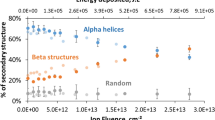Abstract
THE oxidation of ferrous ions in dilute sulphuric acid solution by X- and γ-radiation has attracted attention since the work of Fricke1,2 as a possible method of integral dosimetry for aqueous media3. A study has now been made which confirms that the rate of oxidation with dose is essentially independent of the concentration of ferrous ions in the region 103 to 10-4 M, and which also shows that this rate is maintained independently of the wave-length of the radiation over a much wider range of wave-length than has hitherto been used in studies of this type.
This is a preview of subscription content, access via your institution
Access options
Subscribe to this journal
Receive 51 print issues and online access
$199.00 per year
only $3.90 per issue
Buy this article
- Purchase on Springer Link
- Instant access to full article PDF
Prices may be subject to local taxes which are calculated during checkout
Similar content being viewed by others
References
Fricke, Amer. J. Roent. Rod. Ther., 18, 430 (1927); Phys. Rev., 31, 1117 (1928). Fricke and Morse, Phil. Mag., 7, 129 (1929).
Fricke and Hart, J. Chem. Phys., 3, 60 (1935).
For example, Stenström and Löhmann, Radiology, 18, 322 (1931).
Shishacow, Phil. Mag., 14, 198 (1932).
Gray and Weigert (unpublished data).
Lea, "Actions of Radiations on Living Cells", 34 (Camb. Univ. Press, 1946).
Author information
Authors and Affiliations
Rights and permissions
About this article
Cite this article
MILLER, N. Oxidation of Ferrous Ions in Aqueous Solution by X- and Î-Radiation. Nature 162, 448–449 (1948). https://doi.org/10.1038/162448b0
Issue Date:
DOI: https://doi.org/10.1038/162448b0
This article is cited by
-
Chemical Effects of Ionizing Radiation in some Gels
Nature (1950)
-
Chemical Measurement of Ionizing Radiations
Nature (1949)
Comments
By submitting a comment you agree to abide by our Terms and Community Guidelines. If you find something abusive or that does not comply with our terms or guidelines please flag it as inappropriate.



